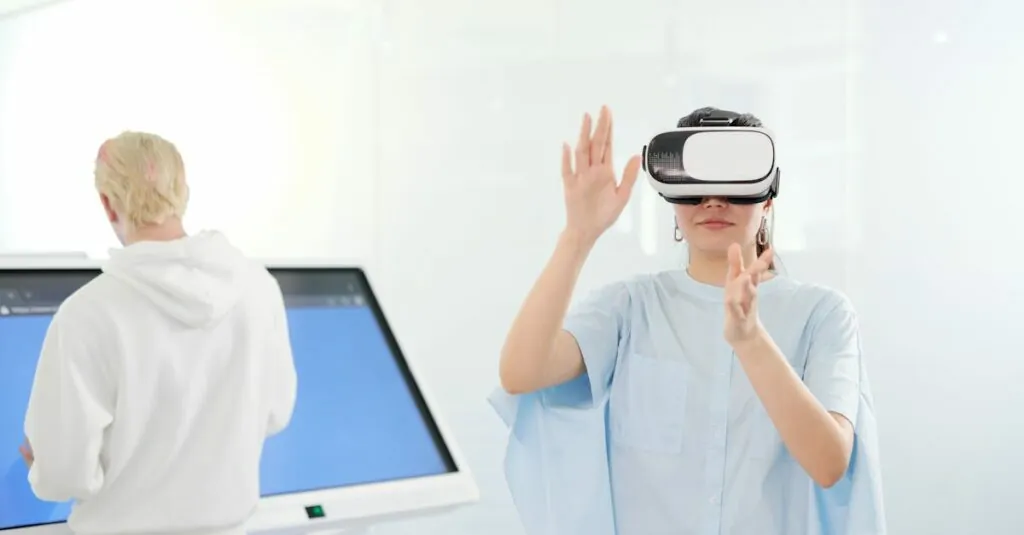Table of Contents
ToggleIn a universe where the possibilities are as endless as the stars, technology in space is transforming dreams into reality faster than you can say “Houston, we have a problem.” From the latest rocket boosters that could give Superman a run for his money to satellites that can track your pizza delivery from orbit, the advancements are nothing short of mind-blowing.
Overview of Technology in Space
Rapid advancements in space technology facilitate significant breakthroughs in exploration. Powerful rocket boosters deliver payloads to orbit efficiently. Sophisticated satellites provide vital data for weather monitoring, communication, and navigation. Ground systems, equipped with cutting-edge software, support mission planning and operations.
Automation plays a pivotal role in modern spacecraft. Robotics enhance operational capabilities, allowing for repairs in harsh environments. Artificial intelligence systems analyze vast amounts of data, improving decision-making processes in real-time. Communication technology enables instant sharing of information between Earth and missions in space.
In recent years, reusable launch systems, such as SpaceX’s Falcon 9, have revolutionized access to space. These innovations reduce costs and increase frequency of launches. A variety of vehicles like crewed spacecraft and rovers expand human presence beyond Earth.
Space telescopes, such as the Hubble and James Webb, capture stunning images, contributing to our understanding of the universe. These instruments reveal distant galaxies, stars, and exoplanets, enriching astronomical research. Data gathered from these endeavours informs theories about cosmic events and planetary systems.
Advancements in propulsion technology improve travel efficiency. Electric propulsion systems, leveraging ion or plasma, enhance spacecraft longevity. Emerging technologies, like solar sails and nuclear thermal propulsion, show promise for future long-duration missions.
The combination of these technologies reshapes the landscape of space exploration and investment. Governments and private sectors invest heavily in research and innovation. Sustainable practices are prioritized, aiming to minimize space debris while maximizing scientific output.
Significant Technologies Harnessed in Space Exploration
Innovations in space technology significantly enhance exploration efforts. Various tools contribute to a deeper understanding of our universe.
Satellites and Their Impact
Satellites play a crucial role in space exploration. Weather monitoring systems depend on satellite data for accurate forecasts. Communication satellites enable global connectivity and data transmission. Navigation systems rely heavily on satellites for precise positioning, revolutionizing travel and logistics. Scientific satellites gather information on atmospheric conditions, aiding climate research. Advanced imaging capabilities contribute to Earth observation and disaster management. These technologies offer invaluable insights and support various sectors on Earth and beyond.
Space Probes and Rovers
Space probes and rovers expand our knowledge of celestial bodies. Unmanned probes traverse the solar system, collecting data on planets and asteroids. Missions like Voyager provide long-range insights into outer planetary systems. Rovers, such as Curiosity and Perseverance, explore Martian terrain, performing geologic assessments. They analyze soil and atmospheric samples, revealing vital information about potential habitability. Teleoperated tools facilitate remote assessments, crucial for discoveries about other worlds. Advancements in robotics enhance agility and efficiency for exploration missions.
Innovations in Space Travel
Innovations in space travel focus on enhanced designs and advanced technologies.
Spacecraft Design and Engineering
Spacecraft design prioritizes efficiency and functionality. Innovative materials improve durability and reduce weight. Modular designs allow for easy upgrades and repairs, enabling longer missions. Advanced systems for life support ensure crew safety during extended periods in space. Human factors engineering optimizes habitat layouts for better crew comfort and productivity. Finite element analysis software enables engineers to simulate spacecraft behavior under various conditions, ensuring reliability and performance.
Propulsion Technology Advances
Propulsion technology drives the future of space exploration. Electric propulsion systems enhance efficiency, providing continuous thrust with minimal fuel. Innovative concepts like solar sails utilize sunlight for propulsion, opening new pathways for deep space travel. Liquid and solid rocket engines benefit from improved combustion efficiency, increasing payload capacity. Hybrid propulsion systems combine the advantages of both liquid and solid fuels, optimizing performance. Ongoing research into nuclear thermal propulsion promises faster travel times for crewed missions to distant destinations.
The Role of Artificial Intelligence in Space
Artificial intelligence significantly enhances capabilities in space exploration, driving efficiency and precision in operations.
Autonomous Systems in Space Missions
Autonomous systems streamline missions by enabling spacecraft to operate independently in challenging environments. Robotics equipped with AI make real-time decisions during operations, which reduces reliance on ground control. These intelligent systems manage spacecraft functions, conduct repairs, and navigate harsh terrains. Notably, Mars rovers like Curiosity and Perseverance utilize autonomous navigation to traverse diverse landscapes, allowing them to conduct scientific research without continuous human oversight. Advanced automation also increases overall mission safety by minimizing risks associated with human error in remote operations.
Data Analysis and Machine Learning
Data analysis supports space missions through rapid interpretation of vast information sets. Machine learning algorithms analyze data collected from satellites and probes, transforming raw data into valuable insights. For instance, AI processes images from telescopes, uncovering celestial phenomena and enabling discoveries. Additionally, it helps predict atmospheric conditions by evaluating historical weather data, paving the way for improved forecasting and disaster preparedness. These advancements empower scientists to make informed decisions, ultimately enhancing our understanding of the universe while providing crucial support for ongoing space exploration efforts.
Future Trends in Space Technology
Technological advancements in space continue to evolve rapidly. Innovations are demonstrating the immense potential of commercial ventures and international collaborations.
Commercial Space Ventures
Private companies are redefining access to space. SpaceX and Blue Origin lead the charge in developing reusable rockets, significantly lowering launch costs. These endeavors enhance the viability of satellite deployment, space tourism, and even asteroid mining. Investments from numerous startups focus on satellite technologies, addressing global communication gaps. The emergence of in-space manufacturing techniques promises to revolutionize resource use, enabling construction and repairs at orbital facilities. As competition grows, innovation accelerates, benefiting the entire space industry.
International Collaborations in Space Tech
Global partnerships are fostering significant advancements in space technology. NASA and the European Space Agency often work together on ambitious projects such as the Artemis program, which aims to return humans to the Moon. Collaborations between countries, including China and Russia, contribute to expansive research and exploration initiatives. Projects like the International Space Station illustrate the power of unity in addressing complex challenges. Teams from various nations share expertise, pooling resources to enhance scientific output. This spirit of cooperation ensures progress in addressing issues like climate change and sustainable resource management in space.
The evolution of technology in space is nothing short of extraordinary. With each breakthrough, humanity inches closer to unlocking the mysteries of the universe. Innovations in propulsion and automation are transforming how missions are conducted and how data is gathered.
As private companies and international collaborations continue to emerge, the future looks promising. These advancements not only enhance exploration but also pave the way for sustainable practices in space. The ongoing investment in research and development ensures that the journey into the cosmos will be filled with discoveries that could benefit life on Earth. The next chapter in space exploration is just beginning, and its potential is limitless.







